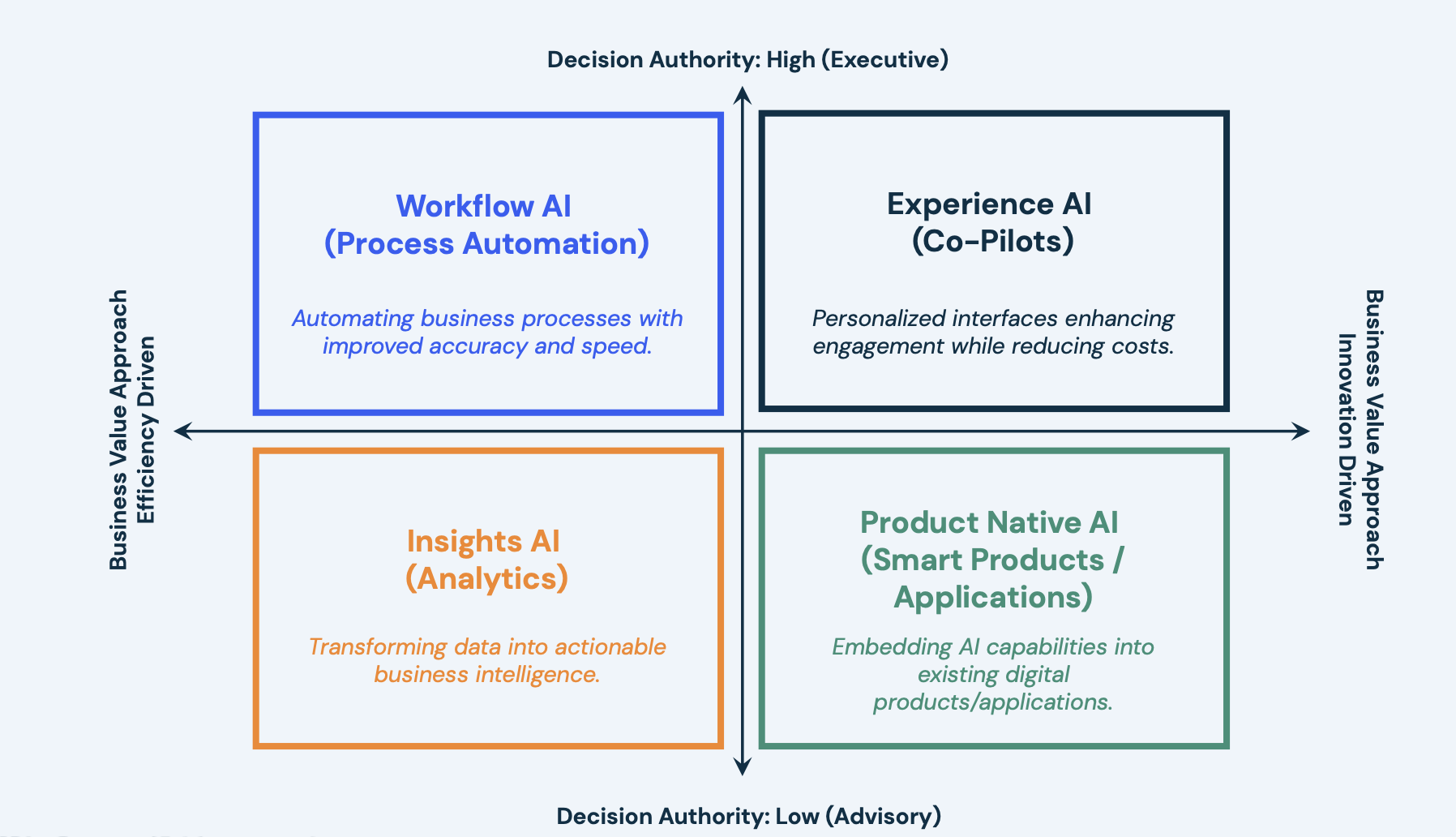
As AI transforms business operations, executives face a critical challenge: how do you prioritize AI investments to deliver real value? With countless AI possibilities — from chatbots to automation to analytics — many organizations struggle to build coherent AI strategies that align with business objectives.
The Four-Quadrant AI Framework cuts through this complexity by categorizing enterprise AI initiatives along two crucial dimensions that every leader understands: Decision Authority (how much autonomy you give AI systems) and Business Value Approach (whether you’re focused on efficiency or innovation).

The Four Quadrants Explained
- Workflow AI (Process Automation) — High Authority, Efficiency Focused
This is where AI takes the wheel on your business processes. Think intelligent automation that goes far beyond traditional RPA. While old-school automation provided the “arms and legs” through rule-based tasks, agentic AI now serves as the “brain” — making contextual decisions, handling exceptions, and adapting on the fly. Healthcare organizations are using this for claims processing and automating prior authorization, while retailers automate inventory management and order fulfillment. - Experience AI (Co-Pilots) — High Authority, Innovation Focused
Here, AI becomes your customers’ and employees’ intelligent assistant. These are the chatbots and virtual agents that don’t just answer questions — they understand context, learn preferences, and proactively help. Contact centers are being transformed as AI co-pilots handle complex inquiries while supporting human agents with real-time insights. - Insights AI (Analytics) — Low Authority, Efficiency Focused
This quadrant transforms data into actionable intelligence while keeping humans in the decision-making loop. Advanced analytics and predictive modeling reveal patterns you’d never spot manually. Hospitals use this for population health analytics, while retailers leverage it for demand forecasting and customer behavior analysis. - Product Native AI (Smart Products) — Low Authority, Innovation Focused
Rather than building new AI systems, this approach embeds intelligence into existing products and applications. Your EHR gets smarter diagnostic support, your CRM predicts leads automatically, your e-commerce platform personalizes recommendations. The AI works within product constraints, often purchased rather than built, limiting customization but accelerating deployment.
Why This Framework Changes Everything
- Strategic Clarity: Instead of chasing every AI trend, you can systematically evaluate where each initiative fits and why it matters to your business.
- Risk Management: The Decision Authority dimension naturally guides governance — you’ll manage a diagnostic AI assistant very differently than an autonomous claims processing system.
- Portfolio Balance: The most successful organizations don’t just focus on one quadrant. They build balanced portfolios that capture quick efficiency wins while investing in innovation opportunities.
- Evolution Pathway: Use cases naturally evolve across quadrants. Analytics insights (Insights AI) often become automation opportunities (Workflow AI). Customer service chatbots (Experience AI) reveal processes ready for full automation.
Your Next Steps
The framework provides a roadmap for AI maturity:
- Start with Assessment: Categorize your current and potential AI use cases across the four quadrants
- Balance Your Portfolio: Ensure you’re not over-investing in any single approach
- Sequence Strategically: Build capabilities progressively, using lower-risk quadrants to develop trust and expertise
- Plan for Integration: Design AI initiatives that can work together as you scale
The Bottom Line
AI success isn’t about having the coolest technology — it’s about aligning AI capabilities with business value and organizational readiness. The Four-Quadrant AI Framework gives you that alignment.
Organizations using this structured approach are seeing faster AI adoption, clearer ROI, and more sustainable transformation. They’re not just implementing AI; they’re building intelligent enterprises.
Disclosure: This content was created through collaboration between human expertise and AI assistance. AI tools contributed to the research, writing, and editing process, while human oversight guided the final content.


